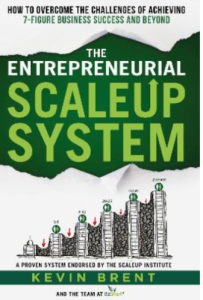By Kevin Brent, below, author of The Entrepreneurial ScaleUp System
 Thomas Edison is credited with saying ‘Success is 1% inspiration and 99% perspiration’ – and it is true for business. If you are still searching for that magic wand that will transform your business into everything you ever wanted it to be, then perhaps you are not ready for this book. Sure, there are frameworks and ways of approaching things that will help you, but it is ‘executing’ consistently well over time that will make the difference. Every now and then we may have a ‘light bulb’ moment, but mainly it is about the cumulative effect of multiple small steps in the right direction. This is essentially about creating, implementing and maintaining good ‘habits’.
Thomas Edison is credited with saying ‘Success is 1% inspiration and 99% perspiration’ – and it is true for business. If you are still searching for that magic wand that will transform your business into everything you ever wanted it to be, then perhaps you are not ready for this book. Sure, there are frameworks and ways of approaching things that will help you, but it is ‘executing’ consistently well over time that will make the difference. Every now and then we may have a ‘light bulb’ moment, but mainly it is about the cumulative effect of multiple small steps in the right direction. This is essentially about creating, implementing and maintaining good ‘habits’.
In this extract, we are going to look at two fundamental habits that will enable you to get more done in 90 days than most businesses get done in a year! These are:
- Putting in place a 90-day planning cycle
- Implementing an effective business ‘rhythm’ (the beat of an effective company) starting with an effective weekly team meeting
It doesn’t matter if you are the only employee of the business, or if you have thousands of employees, these two interlinked habits properly embedded will make an enormous difference to your business over time – providing all sorts of great things like clarity, focus, alignment and accountability to name but a few ‘biggies’ as well as a forum for keeping on top of the day to day and addressing any challenges that come along.
The first thing is to decide on your 90-day cycle and get a half-day recurring planning session in your calendar and those of your leadership team. You may not have what you would call a ‘leadership team’ in place but you will have people either in or linked to your business that you would value being part of that session. These need to be people that you trust and who can help with identifying priorities for the business. If you have a handful of employees then it may well be all of them but generally you want at least three and up to maybe six or seven at the most to enable things to be kept on track.
You may like to use the calendar quarters (Jan to end March, April to end June etc) which works with many business year ends of the end of March, or you may wish to tie in with your year end if different – it doesn’t really matter.
At this stage the agenda can be very simple – the aims are simply to:
- Review how things have gone in the last quarter against what we wanted to achieve
- Review how we are doing against where we are headed – are we going in the right direction? – Strategy
- Check on the culture in the business. What team issues do we need to address? – People
- Review how ‘operations/client delivery’ are going – Execution
- Check the financials are ok – Cash
- Identify 5–7 priorities for the next 90 days (What does ‘good’ look like for the business in 90 days?)
- Develop 3–5 individual priorities (or rocks) for each of the leadership team (What does good look like for me in 90 days?)
- Identify a few key actions for each rock
Try to make sure that the 5–7 business priorities are the ‘big things’ you want to achieve and are in line with where we are headed and that the rocks link to the priorities, in other words that there is consistency throughout. The idea here is that if everyone delivers on their actions, that should mean they deliver on their rocks. If everyone delivers on their rocks, that should mean the business achieves its priorities for the quarter. If the business achieves its priorities for four quarters, it should achieve where it is headed for the year etc etc.
Don’t worry at this stage about running the ‘perfect’ 90-day planning session. The most important thing is to get started – perfection can come later!
The second habit is to put in place or hone your Business Rhythm – particularly an effective weekly team meeting. This is the ‘lifeblood’ of your business, ensuring that you keep focused and on track with your rocks and priorities. Essentially this is about ‘mastering execution’ and ensuring the right stuff gets done. 
Most businesses will have weekly team meetings already in place – but what we have found is that the majority are very operational based. They tend to focus on client delivery/ operations and do not generally include progress against the bigger-picture priorities. If you have more than 20 employees in your business, you may have a senior leadership team. Do they have their own weekly meeting separate from any operational team meetings? If you are smaller and essentially one team, then this might serve as a great agenda for the weekly meeting.
Kevin Brent is author of The Entrepreneurial ScaleUp System

